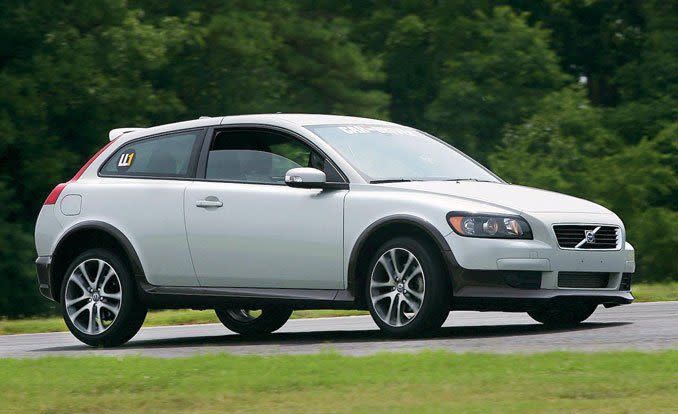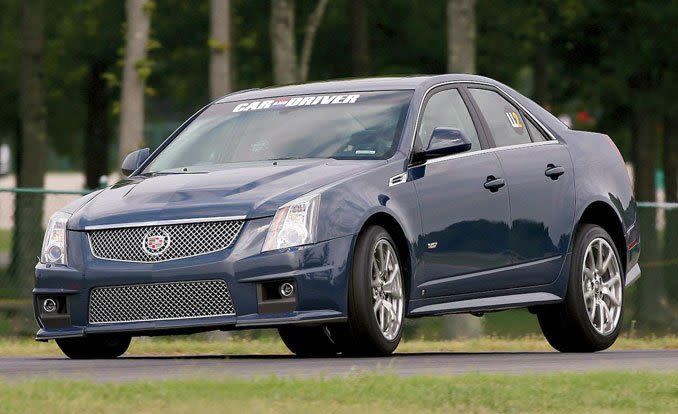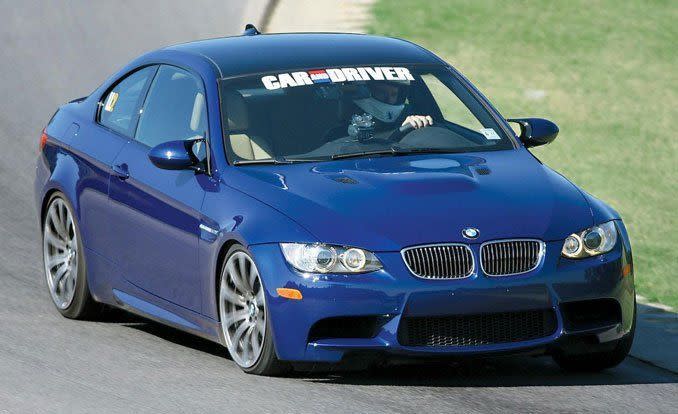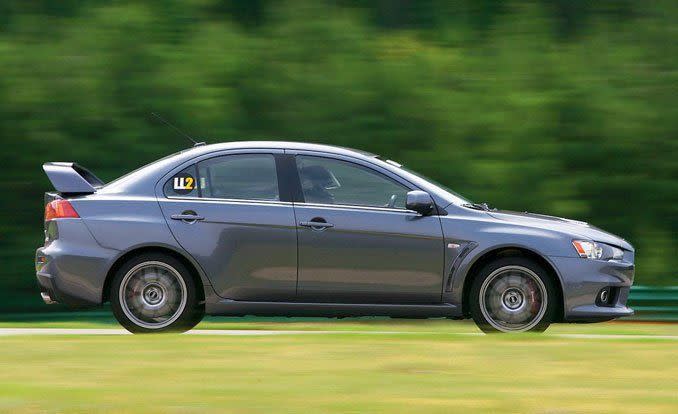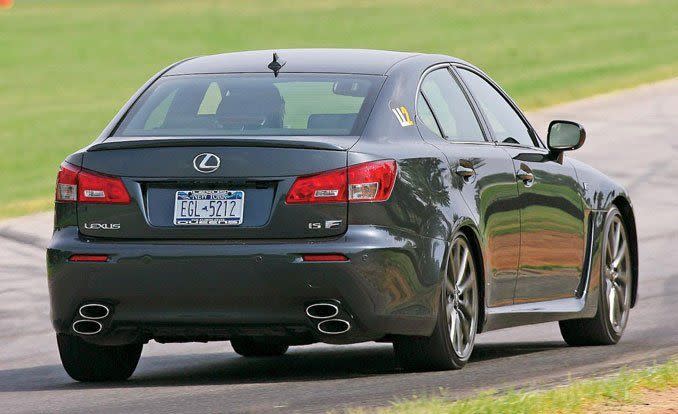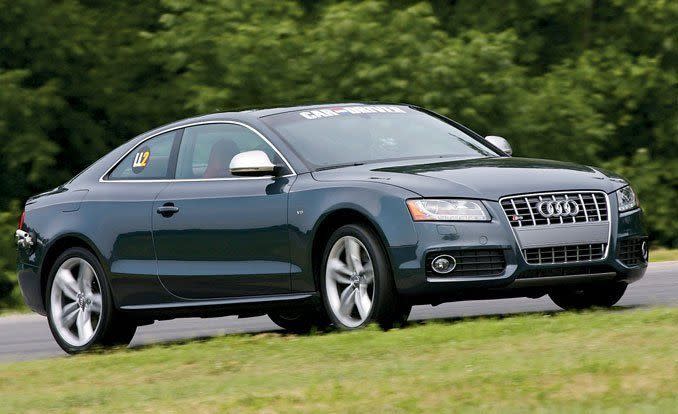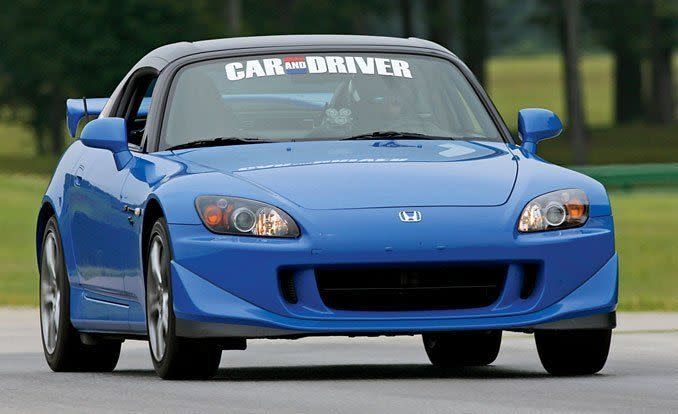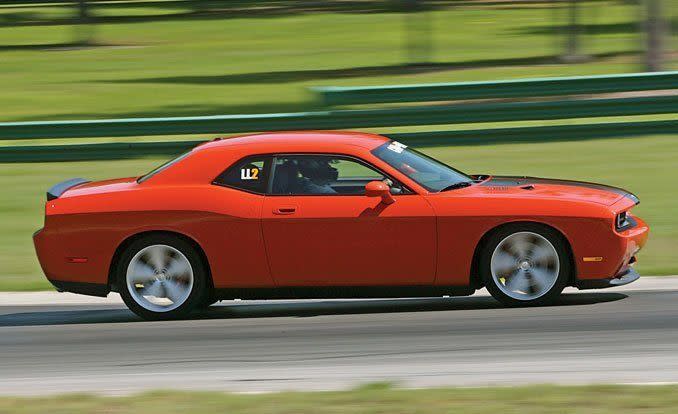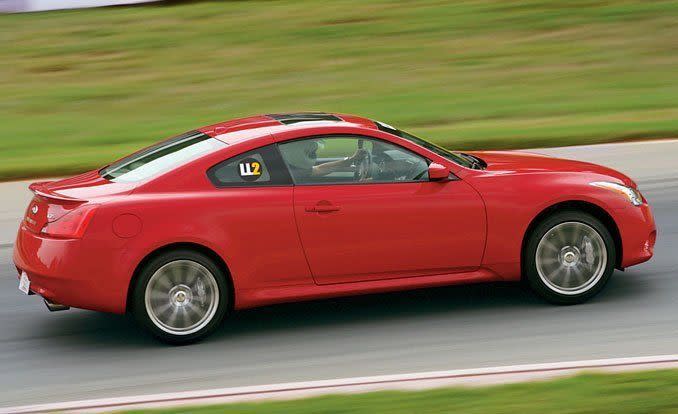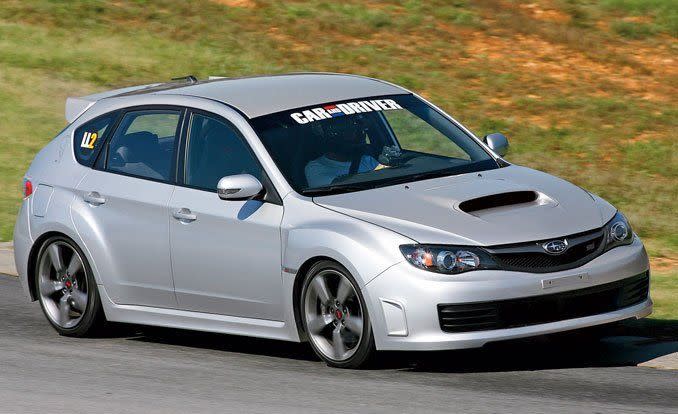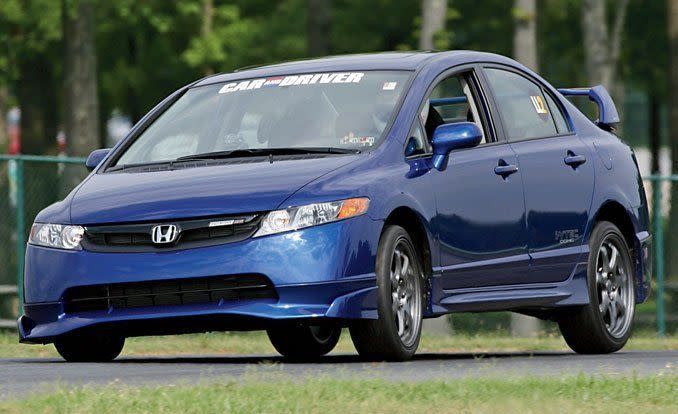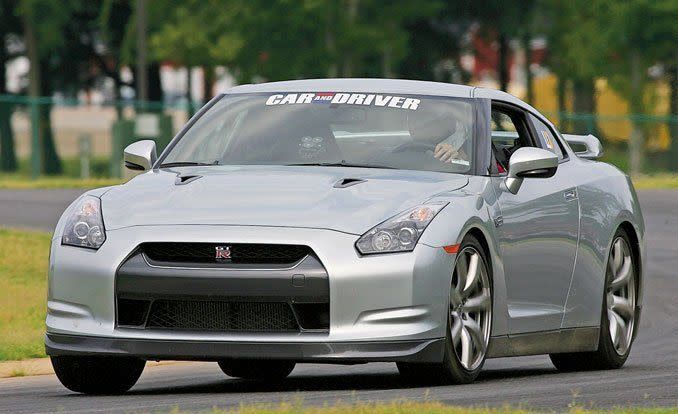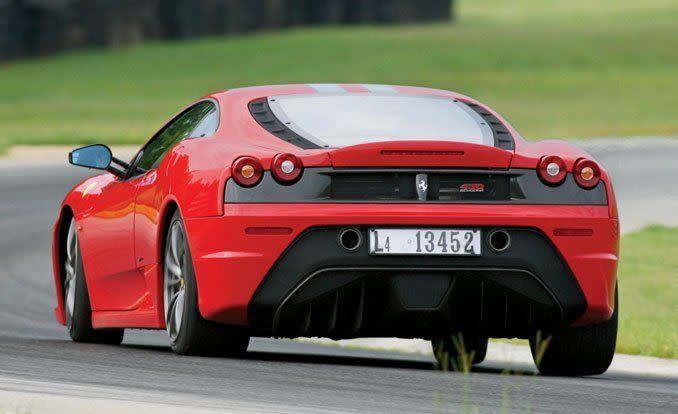Lightning Lap 2008

What car—for the money—delivers the best combination of power, handling, and braking? That question is fundamental to the ongoing mission of this magazine and the core element of all our road tests. We should also point out that those traits are the key ingredients of a car’s fun-to-drive (FTD) quotient, something we value far more than cup holders and/or trunk volume.
But—and this is widely overlooked—the elements of FTD are also the key components of active safety, a vehicle’s ability to respond to and avoid an accident situation. The lane-change exercise, part of our comparison-test regimen, provides insight to this ability, but Lightning Lap delivers an indelible blueprint. Unless you’re a taxi driver in Baghdad, you might argue that no accident-avoidance situation goes on for three minutes, but of course our interest extends beyond dodging drivers whose text messaging overrides their attention to the road. We want to see how well a wide variety of performance cars combine their various dynamic elements in absolute terms in a controlled environment.
Controlled environment means racetrack, and for Lightning Lap that means the 4.2-mile Grand Course at Virginia International Raceway, near Danville, Virginia. This beautiful road circuit is an outstanding blend of fast chutes, blind-entry corners, and lots of changes in elevation, including a series of climbing esses that’s one of the most challenging sections of racetrack in America.
We rank our finishers strictly on lap times, taking the best run achieved by each car during our two-day event. The cars are grouped by price, and there was some very fast traffic this year in the upper groups (LL3 and LL5; there were no cars in the LL4 price category). The four fastest all lapped VIR quicker than our previous absolute record of 2:58.2/82.7 mph. How much quicker? Read on. And let the games begin.
For Autoblog's coverage of our story, click here.
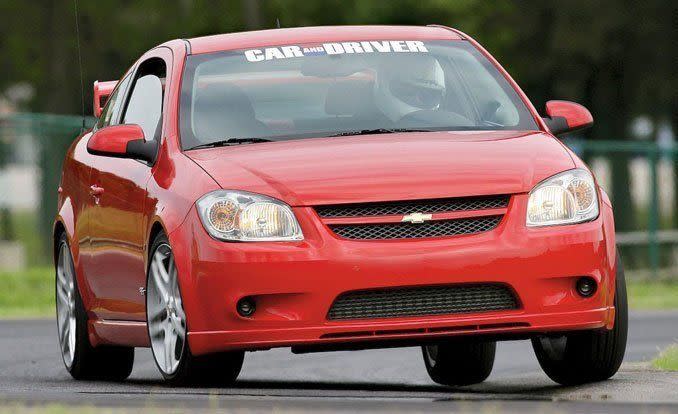

We’re massively impressed with the new front-wheel-drive champion of the LL1 class, the Chevrolet Cobalt SS. Not only did it lop three seconds off the Mazdaspeed 3’s 2007 front-drive record of 3:16.0, it was only a half-second behind the overall LL1 record of 3:12.5 set by the Nissan 350Z Track in 2006.
Two years ago, a supercharged Cobalt SS with 205 horsepower recorded a respectable 3:20.6. We invited the ’08 Cobalt SS because it has a new 260-hp, 2.0-liter direct-injection four-cylinder turbo engine and a host of chassis upgrades including wider tires and larger brakes.
The changes made a huge difference at the track as the Cobalt’s new brakes resisted fading, its wider tires maintained their hold lap after lap, and its compliant and balanced chassis made it easy to exploit the phenomenal grip.
Gobs of power from the new engine and an optional limited-slip diff allowed the Cobalt to take most of the track in third gear. The SS hurtled forward with an anger missing in the rest of LL1 and much of the LL2 group. Despite the explosive power and front weight bias, the Cobalt SS resisted the typical understeer found in front-drive cars. The SS goes about its business with almost no drama. You only realize how quick it is when you arrive at start-finish and wonder, “How’d I get here so fast?”

In contrast, the Dodge Caliber SRT4’s high center of gravity, persistent body motions, and understeer made it a challenge to make the most of its 285 turbocharged horses. Not helping the cause was an open front differential that resulted in one tire spinning madly whenever the engine was sucking in boost. Lapping the Dodge was an exercise in managing understeer; no other vehicle abused its front tires as sadistically as the Caliber. But this weakness sometimes worked in its favor because the understeer inspired confidence and allowed for fast corner entries.

The final player in LL1 was the Volvo C30 T5 Version 2.0. Although the responsive and basically silent 227-hp, turbo five-cylinder had the torque and horsepower to entertain, the Volvo was mostly let down by its all-season tires, which, not surprisingly, weren’t up to track use.
Despite the low-grip rubber, the Volvo’s body motions were well damped, and the chassis felt light on its feet. Lift-throttle oversteer and trail braking tucked the C30 into corners with ease, and comfortable, form-fitting seats, plus strong brakes, made lapping easy. We wonder how the car would have fared with a better set of tires.

With a herd of 15 cars, 11 more than the LL2 group in our 2007 derby, this category was by far the biggest, ranging from predictably fast rides such as the Corvette Z51, a big favorite last year, to some that we expected to sizzle but didn’t: A particular disappointment was the Subaru WRX STI.
Although the Z06 is the more serious track car, a base Corvette with the slightly stiffer Z51 suspension package will satisfy all but the most demanding weekend warriors and save them as much as $23,000 in the process. The only dynamic trait that drew even faintly negative mention last year—slightly numb steering—was improved for the 2008 model year, as was the shifting, and 436 horsepower from the LS3 V-8 (versus 400 for the ’07 Vette) doesn’t hurt, either.
So we weren’t too surprised when the current car trimmed 2.4 seconds off the best time posted by its predecessor. Some may note that the 2007 Corvette was third fastest overall, regardless of class, whereas the ’08 car was fifth. But as noted earlier, there were some very quick cars at this Lightning Lap.

If the Corvette was predictable as the LL2 champ, the car that put up the second-best lap time in the category was a surprise. Yes, the CTS- V’s 6.2-liter supercharged LSA V-8 makes 556 horsepower, 120 more than the Vette, and, yes, horsepower definitely counts on this circuit.
But the new super-Caddy also weighs 996 pounds more than the Vette, and weight is never an asset on a racetrack. Which makes the Cadillac’s performance nothing short of remarkable. Remarkable thrust from the LSA with no hint of the angry bull bellow that afflicted the previous CTS- V. Remarkable, too, is its six-speed manual gearbox, providing precise shifts and crisp engagements. Remarkable balance, allowing the driver to drift and pivot this big sedan with ease. Remarkable brakes, offering formidable stopping power without a hint of fade, lap after lap.
You may also find it remarkable that the BMW M3’s best lap trailed the big Caddy’s best time by 1.6 seconds. The CTS- V does enjoy a power-to-weight edge over the M3, 7.7 pounds per horsepower versus 8.8, and the Cadillac’s chassis and suspension are good enough to exploit that edge. But the real difference was the M3’s automated manual gearbox, which didn’t want to downshift on command, and our best lap was achieved while driving the car in pure automatic mode.

Nevertheless, the M3 is an exemplary blend of track-day performance and everyday drivability. Like previous M3s, it delivers the kind of car-and-driver dynamic interface we normally associate with pure sports cars. But unlike its hard-edged predecessors, it’s as compliant and civilized as other 3-series Bimmers when comfort, rather than absolute urgency, is the priority. Is the steering a little light for some tastes? Maybe. But when the transmission is operating properly, it’s hard to find any fault with this super sports coupe.

The Mercedes C63 AMG toured the challenging VIR layout almost as quickly as the M3—the best-lap difference was less than a second—but the Bimmer achieves haste with a parlay of power and finesse, whereas the Benz is more of a brute-force player.
Although the Benz outweighed the Bimmer by 364 pounds, it made the most of VIR’s fast sections, abetted by the function of its seven-speed manumatic transmission, excellent brakes, and a stability-control system that allowed some drifting. But the extra mass limited quick transitions, and the stiff suspension made the fast uphill esses a little more thrilling than one would wish.
There was a substantial gap between times posted by the C63 and the rest of the LL2 pack, where the cheeky little LL1 Cobalt SS inserted itself with a 3:13.0 lap.

Quickest of those behind the Cobalt was the Mitsubishi Lancer Evo MR, a car that emerged as the scalpel of the Lightning Lap sedan set, dissecting VIR’s technical sections with surgical precision and providing absolute confidence in the uphill esses. The only elements that kept the Mitsubishi from the 3:12 lap bracket were its power-to-weight index—at 3650 pounds, the 291-hp Evo MR is 25 pounds heavier than the 414-hp M3—and a slightly relaxed shift response from the otherwise excellent six-speed automated manual transmission.

Nevertheless, the Evo was quick enough to shade the BMW 135i, albeit by less than a half-second. There were a couple of logbook comments about the Bimmer’s rubbery shift action and excessive up-and-down motion in the suspension, the trade-off for the 135i’s excellent ride quality.
But these were more than offset by the thrust of the 3.0-liter, twin-turbo straight-six—300 horsepower, 300 pound-feet of torque—plus outstanding brakes and tenacious grip. At its limits, the 135i lapsed into understeer, but those limits were high, and the BMW inspired total confidence. “Knows how to follow orders,” readeth the logbook.

The Lexus IS F is another car that knows how to follow orders, and the VIR take-away lesson was that those orders should be chosen judiciously, particularly at higher speeds. Getting to higher speeds is something the IS F does very well indeed. The 416-hp, 5.0-liter V-8 and eight-speed automatic transmission conspire to get this Lexus down the road in a serious hurry, and the aural accompaniment is habit-forming. We’d also rate the tranny’s manumatic function as good as any. There’s plenty of grip, too, and powerful, consistent braking.
But at high speeds, particularly in VIR’s climbing esses, the IS F’s behavior morphs from eager to darty, eroding driver confidence. Our notes suggested that steering inputs were a bit dramatic and running over curbs in fast turns could be downright scary. A little attention to springs and damping might make this eager contender a real champ.

If understeer took some wind from the BMW 135i’s sails, it was a virtual sea anchor for the Audi S5. When this new breed of Audi coupes came along last year, the company made much of the fact that the front/rear weight bias had been improved.
Nevertheless, the entire mass of the engine—a stout, 7000-rpm 4.2-liter V-8 with a Wagnerian exhaust note—still resides ahead of the front axle’s center line, and weight distribution still suffers as a result: 56.9 percent front, 43.1 rear. And the net effect of this, magnified by a substantial curb weight (3910 pounds), is massive resistance to turn-in that increases as a function of speed.
The S5’s V-8 delivers impressive low-end power, its six-speed manual gearbox is exceptionally crisp, and its brakes are as good as any. But for all its style and speed, this car is not really happy on a racetrack.

Honda’s S2000 CR, on the other hand, is happy to find a racetrack, which you’d expect of a sports car, especially one with initials that stand for Club Racer. However, this one wasn’t as happy as we anticipated.
Like the Dodge Viper ACR, the Honda CR is a suspension and aero package conceived to make the car quicker without adding horsepower, albeit at a much more modest level. A few runs up VIR’s climbing esses convinced us that perhaps the downforce-generating aero elements really do work—this was one of the few cars that allowed us to do the series of turns flat out, although it also was endowed with the fourth-lowest horsepower rating.
So why weren’t our lap times quicker? The culprit was brakes. Racing has demonstrated that the S2000’s brake system is first-rate, but the stock brake pads are not, and they faded almost out of existence after just two laps, never to fully revive.

As track cars go, VIR proved that the Dodge Challenger SRT8 is a lovely street rod. It did turn better times than the Charger SRT8 of the 2006 Lightning Lap but largely because of its higher-performance tires and lower curb weight.
At 4146 pounds, the Challenger was 95 pounds lighter than the Charger, but nonetheless, the driver never, ever ceases to be aware of its mass, aggravated by numb steering. And the automatic transmission didn’t help, either (Memo to Dodge: Enlarge the IP gear-selection readout—it’s almost invisible).
We’d hoped for a manual model, available for ’09, which would have made a difference. But even so, if the Audi S5 isn’t overjoyed to be on a racetrack, the Challenger is downright miserable.

With 218 supercharged horsepower in a 2029-pound mid-engine sports car, we expected to see much better times than we achieved with the Lotus Elise SC. The naturally aspirated Elise (190 horsepower) that ran at VIR in 2006 scampered around the 4.2-mile course in 3:09.2 versus 3:16.6 for the supercharged version.
That earlier Elise was equipped with wider and stickier tires, which offset the SC’s extra punch. And we experienced gear-selection drama with the vague engagements of the six-speed manual gearbox, which also held this car back.

Despite its well-balanced and responsive rear-drive chassis, the Infiniti G37 Sport didn’t feel terribly comfortable on the track and required plenty of cooling time between hot laps. Fingers point to its 3723-pound weight (which led to brake fade after only a few big stops), an engine that didn’t quite feel like 330 horses, and easily overheated and thus slippery tires. Pound the brakes hard, and the G37 assumes a crash is imminent and cinches up the seatbelts—as if we needed more evidence that this car was not suited to track workouts.

The only real disappointment in this roundup, though, was the Subaru Impreza WRX STI. The new STI has a sophisticated all-wheel-drive system delivering lots of driver selectability, plus the 305-hp thrust of its turbocharged flat-four engine, which should add up to performance that’s at least on par with that of previous members of the STI series.
But Subaru product planners wanted to broaden the STI’s appeal, making it more family friendly. So they made it hatchback-only (diminishing the structural rigidity found in a formal sedan) and softened the suspension.
The racetrack result is lifeboat body roll, mulish understeer, reluctant transient response, and vague steering feel. That is mitigated to some degree by outstanding braking performance, and of course, the cushy suspension payoff is creamy ride quality. Chalk those up on the family side of the ledger.
However, none of this adds up to a car that’s gonna make daddy happy at a track day. Especially if one of the other daddies shows up in a new Mitsubishi Evo.

The Volkswagen R32 is essentially a pricier version of the GTI with all-wheel drive; larger, fade-free brakes; and a very classy interior. Its 250-hp, 3.2-liter V-6 is bolted to VW’s outstanding automated manual six-speed transmission called DSG.
Although ride quality can be a bit harsh on warty pavement, the R32 is otherwise a sweetheart—responsive, eager, predictable, and easy to take to its limits. Unfortunately, at VIR those limits turn out to be a little lower than in most of the other cars in this group, imposed by the R32’s substantial curb weight of 3555 pounds.
As a result, the sense of competence and confidence the R32 inspires at the top of VIR’s esses is due, in part, to arriving there at lower speeds.

The Mugen treatment gives the Civic Si what Honda calls a “track-ready suspension.” That suspension is 0.6 inch lower, the damping is firmer, and the wheels are both wider and lighter. Add to that BFGoodrich g-Force T/A rubber that is more suited to track usage than the Si’s rubber, and the result is a buttoned-down chassis that exhibits very little body roll, resists understeer, and never makes an untoward move. All of the floppiness we complained about in the base Si has been eliminated in the Mugen.
This chassis feels as though it could handle about 100 more horsepower, but with only 197 horses on tap, the Mugen couldn’t quite rocket out of corners. While lapping, keeping the torqueless engine on boil, in this case between 6000 and 8000 rpm, felt suspiciously like work as the Civic required more shifts than its competition. Mugen didn’t see fit to upgrade the braking system, which, like the Si’s, suffered from fade after only a few big, nasty stops. Still, the Mugen chassis tweaks did lop 1.7 seconds off the time of the 68-pound-lighter Civic Si coupe from the ’06 Lightning Lap.

The two cars in this segment, the Dodge Viper SRT10 ACR and the Nissan GT-R, were both effortlessly easy to drive but for widely different reasons.
The GT-R was the robot of the group, faithfully obeying commands and making us look better than we are. At its limits, the car must plead guilty to massive understeer, but it’s a safe if unsatisfying trait. The magic is the traction the car gets with four-wheel drive. We could floor the throttle long before corner exits and let the GT-R figure out how to put down the power.
If maximum speed is the goal, make sure to opt for Dunlop SP Sport 600 tires, which made the GT-R more than three seconds quicker than with all-season SP Sport 7010s. We’ve also previously sampled GT-Rs with the other summer tire choice, Bridgestone RE070Rs, and found them to be less grippy and more prone to understeer than the SP Sport 600s. However equipped, the GT-R is certainly quick—its 2:55.6 lap time bettered last year’s Corvette Z06 by more than two seconds—if not the most rewarding car to drive fast on a track.

The Viper is just the opposite. Its ease of use doesn’t come from prominent understeer but rather from a neutral, progressive, perfectly balanced chassis enhanced by aerodynamic downforce. It’s a pussycat, which is a strange thing to say about a car with 600 horsepower. But it’s content to dance gently around the limit, letting the driver comfortably use every bit of the car’s stunning speed. Where the GT-R simply goes out and does the job, the Viper gives the driver the perfect tools to do the job manually. Its friendliness is nothing short of amazing.

Our lungs fought for air while piloting the two breathtaking LL5 entries, the Ferrari 430 Scuderia and the Mosler MT900S.
The visceral-thrill corner is occupied by the Ferrari entry, a car so scintillating in its sound and feel that the quarter-million-plus price tag seems almost reasonable. The wailing V-8 revs to the stratosphere, and the chassis stays securely planted at all times. We ran through a first session with the stability control in the “race” setting, which upped the intervention threshold and gently nudged us back in line. Once we got comfortable with the car, we turned off the system and our laps times got about a second quicker. It’s a car not easily screwed up because the solid structure and sure-footed suspension communicate clearly what’s going on at the contact patches, and of course, the automated manual gearbox makes shifting a no-brainer. The Ferrari may not have been the quickest, but it’s the one car we all wished we could take home.

And then there’s the Mosler. It was just so astoundingly fast that, frankly, our amateur skills could not fully exploit its capabilities. It handles quite well—predictable, glued down, and with outstanding brake feel. But uncorking the 550-hp LS7 V-8 propels this featherweight, 2584-pound car like a cannon shot. That tremendous speed was in itself unnerving. There are subtle bumps on the gently curved start-finish straight that sent the rear end skipping about to the point that we instinctively feathered the throttle. That surely cost us some time, so we pitted for a shock adjustment. When we went back out, a strip of wheel weights fell off, producing enough vibration that our deeply rooted instincts for self-preservation took over and we parked it. Overall, though, it’s a remarkably well-turned-out car. Warren Mosler’s years of work have paid off. It’s like a streetgoing IMSA prototype, and it’s even quicker than its chart-topping time suggests.
The cars featured here are all unmodified production vehicles, but we did request models equipped with performance-enhancing options such as larger brakes, stiffer suspensions, and the best wheel-and-tire packages. After filling each car with premium fuel, setting tire pressures to the manufacturers’ recommended numbers, and checking the oil, we mounted a Racelogic PerformaceBox GPS-based data logger on the windshield to record lap times and other figures. The three drivers were Tony Quiroga, Tony Swan, and Larry Webster. Each was assigned several cars. Weather has a pronounced effect on vehicle performance—a car runs faster when it’s 70 degrees than when it’s 90—so the drivers cycled through their cars twice, running three to five laps per session. The lap times are the best each car produced in either session. Because performance is closely related to price, we grouped the cars in five classes according to base price, as follows:
LL1 (under $30,000)
LL2 ($30,000–$60,000)
LL3 ($60,000–$120,000)
LL4 ($120,000–$240,000)
LL5 (above $240,000)
Technically, a car competes only with others in its class, but to illustrate whether a car overachieved or underachieved the borders of its class, download the chart on the first page.
You Might Also Like

 Yahoo Autos
Yahoo Autos 


